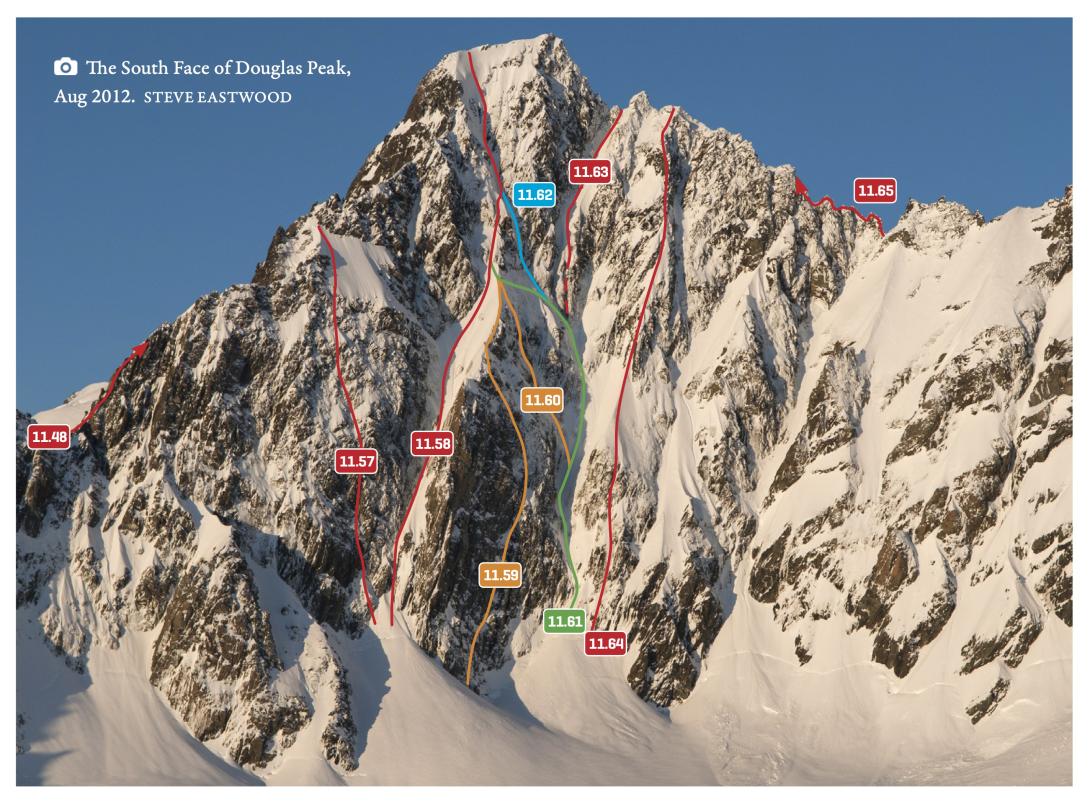The South face of Douglas looms above the Albert Glacier and its steep arêtes create amphitheatres amidst near-vertical rock. The south face throws out a challenge to any climber who ventures under it. Although the main routes on the face are described below, some variations do exist.
Descent: Until recently, the standard descent was over Glacier Peak. If you plan to go this way check that the west face is not too open with crevasses and a bergschrund, and that you have enough rope and gear for a abseil off Douglas towards Glacier Peak. People have got ropes stuck on this abseil in the past. Nowadays many people abseil the face on V -threads which puts you back at your skis ...
Routes
| Reference | Title | Grade | Length | Pro | Quality | Alert | Operations |
|---|---|---|---|---|---|---|---|
| 11.57 | 11.57Jefferies- Uren, III,5,5 | III,5,5 | 0m | ||||
|
Follows a vague gully on the left side of the face, finishing a little over half way up Pioneer Ridge.
|
|||||||
| 11.58 | 11.58Left Hand Gully, IV,4,5- | IV,4,5- | 0m | ||||
|
Where it all began—a classic and highly recommended climb. Follow the narrow couloir that gradually widens and meets the central arête. Continue up, traverse right into the upper Central Gully just above the crux in that line, and on to the summit. The Left Hand Gully is quite a bit easier than the Central Gully, being less steep overall. Remember that in 1968 when the first ascent was made, they still climbed ‘in balance,’ using straight picks so that you had to hold the shaft of the axe out from the ice to prevent the pick popping out. Short ropes, pitons, primitive ice protection—an amazing first ascent.
Follow the narrow couloir that gradually widens and meets the central arête. Continue up and traverse into the upper Central Couloir and up to the summit. A classic and highly recommended climb. |
|||||||
| 11.59 | 11.59 Albert Town Direct, IV,5,WI3,M3 | IV,5,WI3,M3 | 0m | ||||
|
A creative line that runs up the right-hand front face of the central buttress to the central snow arête and finishes up the upper Left Hand Gully.
|
|||||||
| 11.60 | 11.60Interloper, IV,4+ | IV,4+ | 0m | ||||
|
A variation to the Central Couloir route that traverses from the right to the left couloir lower than the original line does, hence missing the central couloir, and involving four pitches of new ground to reach route 11.58. Dave and Lynn had decided to put the belay out of the gully on that left wall and were just missed by large rockfall in the RH Gully so they decided to carry on that line. It was previously named Interceptor in 2003 when climbed by Grant Piper, Paul Scaife, Andrew Haugh, Oct 2003 not realising it had been previously climbed.
|
|||||||
| 11.61 | 11.61Denz/Timms, IV,4+,5 | IV,4+,5 | 0m | ||||
|
Follow the lower Right Hand Gully to near the foot of the obvious narrow notch (at two thirds height), and then traverse up and left, below the headwall of the Central Gully, to cross over the central arête, finishing up Route 11.58.
Start up the RH gully then makes a difficult (1971) traverse left to join the Central arete then finishes up the original LH gully finish. This was the FWA of the South Face of Douglas. |
|||||||
| 11.62 | 11.62Central Gully, IV,5,5+ | IV,5,5+ | 0m | ||||
|
This is one of the great ice climbs of New Zealand—a perfect line on a beautiful face.
Follow the lower right couloir to near the foot of the obvious narrow notch (at 2/3 height), then traverse leftwards into the Central Couloir. Ascend steep ice, for a couple of pitches, which gradually relent, leading to the summit. Superb. |
|||||||
| 11.63 | 11.63Right Hand Gully, IV,4,5 | IV,4,5 | 0m | ||||
|
Climb the gully to an obvious deep notch, which can be ascended or else avoided using a ramp on the left, and then exit via a wide couloir onto the Ayres Ridge. A good route if you like climbing notches.
Climb the couloir to an obvious deep notch, which can be ascended or else avoided using a ramp on the left. Then exit via a wide couloir onto the Ayres Ridge. |
|||||||
| 11.64 | 11.64Far Right Rib, 4+ | 4+ | 0m | ||||
|
Follow the rock rib, right of the Right Hand Gully, which joins the Ayres Ridge.
|
|||||||
| 11.65 | 11.65Ayres Ridge, V,4+ | V,4+ | 0m | ||||
|
An unrelenting ridge between Mt Haidinger and Douglas Peak, with many rock towers varying in soundness. The final rise to the summit of Douglas is probably the hardest section and can be avoided on the east.
|
|||||||
